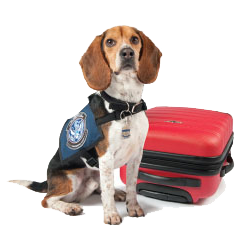International Traveler: Meats, Poultry, and Seafood
[ Back ]
The United States restricts or prohibits the entry of many agricultural products, which can carry foreign pests and diseases that harm American agriculture and our environment. A major pest or disease outbreak could mean higher grocery bills, shortages of certain foods, and devastating losses for our farmers and ranchers. Help us keep American agriculture healthy by following the guidance on this page about products you may want to bring into the United States.

Are you traveling from Canada by Land? Find out which meat, poultry and pet food products that you CAN and CANNOT bring back to the U.S. from Canada's land border. Air travelers should refer to the guidance listed below.
Meats, Poultry, and Seafood that you CAN and CANNOT bring back to the U.S. (choose below)
- Meats
-
USDA does not allow travelers to bring back most cattle, swine, sheep or goat meat or meat products from countries affected with certain serious livestock diseases:
- Foot-and-mouth disease
- Bovine spongiform encephalopathy (BSE)
- Swine vesicular disease
- Classical swine fever
- African swine fever
To find out a country’s status for these diseases, visit our animal disease status page.
Travelers may bring back fresh (chilled or frozen), cooked, cured or dried meat from countries without these diseases if they have official documentation to prove the product’s country of origin. The following items are considered official documentation: package label; written documentation; proof of travel (passport or travel itinerary); origin of flight; receipt of sale; CBP document (based on the officer’s interview of the traveler); a meat inspection certificate; or certificate of origin.
Travelers may bring back boneless meat in commercially packaged, labeled, and contained in unopened hermetically sealed containers or packages that are cooked by a commercial method after such packing to produce articles that are shelf-stable without refrigeration.
Travelers may not bring back more than 50 pounds of an item. Shipments larger than 50 pounds are considered commercial shipments and must meet additional requirements through USDA’s Food Safety and Inspection Service. Contact them at (202) 720-9904 or www.fsis.usda.gov.
Cured hams (prosciutto, Serrano ham, Iberian ham) and salami from areas within France, Germany, Italy and Spain may not be brought into the United States by travelers. These items may only enter in commercial shipments because there are special restrictions that require additional certification and documentation.
- Poultry
USDA does not allow travelers to bring back most poultry meat or poultry meat products from countries affected with certain serious poultry diseases:
- Highly pathogenic avian influenza
- Newcastle disease
To find out a country’s status for these diseases, visit our animal disease status page.
Commercially-packaged and labelled, cooked, shelf-stable poultry items from affected countries that are in unopened packages are allowed. However, travelers may not bring back more than 50 pounds of an item. Shipments larger than 50 pounds are considered commercial shipments and must meet additional requirements through USDA’s Food Safety and Inspection Service. Contact them at (202) 720-9904 or www.fsis.usda.gov.
Cooked poultry meat or poultry meat products from affected countries will be inspected by U.S. Customs & Border Protection. Items appearing to be “thoroughly cooked throughout” will be allowed entry. Items that do not appear “thoroughly cooked throughout” will not be allowed without special certification and an import permit.
Travelers may bring back fresh (chilled or frozen), cooked, cured or dried poultry meat from countries without these diseases if they have official documentation to prove the product’s country of origin. The following items are considered official documentation: package label; written documentation; proof of travel (passport or travel itinerary); origin of flight; receipt of sale; CBP document (based on the officer’s interview of the traveler); a meat inspection certificate; or certificate of origin.
- Seafood
-
APHIS does not regulate the importation of most seafood items. We only regulate breaded seafood products, and only if the breading contains animal-origin ingredients (milk, eggs). Please contact us directly about breaded seafood items.
For all other seafood import questions, contact:
- The U.S. Fish and Wildlife Service at 800-358-2104 or www.fws.gov
- The Food and Drug Administration at 301-796-0356 or www.fda.gov
How Do I Declare Agricultural Items?

USDA-trained dogs help sniff out plants and animal products in luggage and carry-on items on international flights. Make sure you include any agricultural items on your Customs Declaration Form (select form below). This form provides Customs and Border Protection officials with basic information about who you are and what you are bringing into the United States, such as agricultural and wildlife products and whether you have visited a farm prior to traveling to the United States. When you declare, a U.S. Customs and Border Protection official can check your items. This is the only way to be certain that your items are free of plant pests and animal diseases.
Customs and Border Protection (CBP) Forms